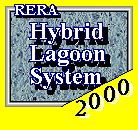
COPYRIGHTS
1999-2009 RERA
All right reserved.
Any Unauthorized
Copying
or Using Prohibited.
Preface
Table
of Contents
Foundation
Hybrid
Lagoon System
Case
Study
Applications
Proposals
11. Water Flow Model and Stirring Characteristics of Hybrid Lagoons.
What kind of water flow model is appropriate to the LLSB treatment method.
Below are listed the conditions of a water flow model suited to the LLSB activated sludge treatment method.
Sludge settling at the basin bottom during the sedimentation period must be diffused completely throughout the entire basin.
The time required for complete mixing must be short, with good stirring efficiency.
The conditions for complete mixing must obtain even when the aerator volume is lowered.
The basin construction must be simple and the basin easy to build.
Because in LLSB activated sludge facilities a single basin is seed for both aeration and final sedimentation, rapid diffusion throughout the basin of the sludge settled at the bottom of the basin during the sedimentation period, with minimal liquid motion, is a fundamental condition of water flow models for use with LLSB facilities. Moreover, complete mixing of the activated sludge with the water to be treated is essential for purposes of instrumentation and control, as well as to obtain clean. Treated water.
From the results of operation of the LLSB treatment facilities at the Tsuga Farm, which employed a circulating waterway and surface mechanical aerators, it was found that considerable time was required for water treatment, due to partial accumulation of sludge at shallow spots in the waterway, and to mixing of settled sludge. The stirring efficiency of the waterway employed was, in terms of volume of liquid, 55 m3 per kW, or less than half the anticipated efficiency. In contrast, the hybrid lagoon facilities at the Takizawa Ham plant have a high stirring efficiency, reaching 211 m3per kW. (Photos 10 through 12).
Hence in circulating waterway facilities, when the aerated volume was controlled in accordance with fluctuations in the intake load and the state of the microorganism processing, incomplete mixing resulted, and aeration control was found not to be possible. The Takizawa Ham lzumikawa plant hybrid lagoon facilities are designed for aeration control in the range from 68 5 kW (58.3 m3/kW) to 19.0 kW (211 m3/kW).
The cost for construction of hybrid lagoon water flow model facilities is but a fraction of that for? Box-type water flow model facilities.